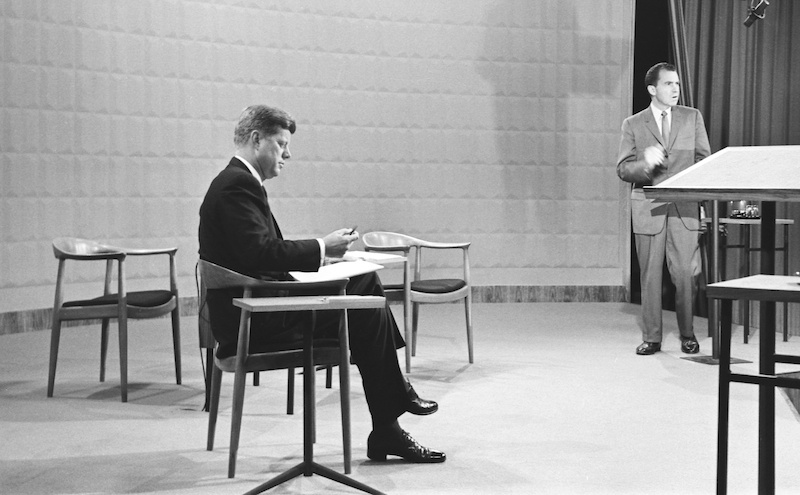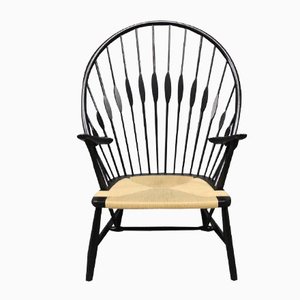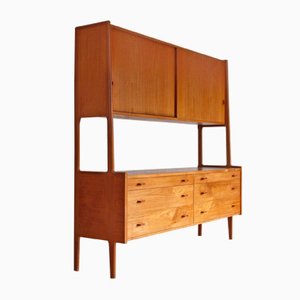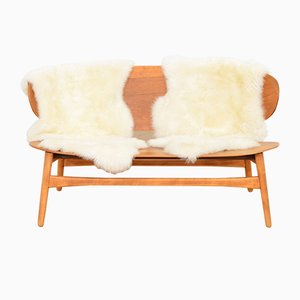Hans Wegner’s The Chair
The One & Only
-
Hans Wegner's The Chair
Image © Katja Kejser & Kasper Holst Pedersen / Courtesy of PP Møbler
-
Hans J. Wegner
Image © Jens Mourits Sørensen
-
The Chair in the PP Møbler workshop
Image © Jacob Ehrbahn
-
The Chair in the PP Møbler workshop
Image © Katja Kejser & Kasper Holst Pedersen
-
The Chair in the PP Møbler workshop
Image © Jacob Ehrbahn
-
The Chair in the PP Møbler workshop
Image © Jacob Ehrbahn
-
The Chair in the PP Møbler workshop
Image © Jacob Ehrbahn
-
Kasper Holst Pedersen, Søren Holst Pedersen, and Ejnar Pedersen of PP Møbler
Image © Katja Kejser & Kasper Holst Pedersen
-
Image © Katja Kejser & Kasper Holst Pedersen / Courtesy of PP Møbler
-
The Chair in soap treated ash
Image © Jens Mourits Sørensen
-
The Chair in soap treated ash
Image © Jens Mourits Sørensen
-
Watertower of the Tønder Museum
Image © Jens Mourits Sørensen
“A chair,” according to Danish designer Hans Wegner, “is to have no backside. It should be beautiful from all angles.” This principle guided Wegner in the design of every one of the 500 chairs he developed during his lifetime—100 of which were ultimately put into production. But of all these, just one, his 1949 Round Chair, went on to earn the internationally recognized nickname of “The Chair,” an honor shared by no other design before or since.
Lauded as “the most beautiful chair in the world” on the cover of the American magazine Interiors in 1950, Wegner’s Round Chair—which features a back and armrests made of one continuous wooden semicircle—quickly became a symbol of Danish Modern design, a style characterized by the simplicity of elegant, even graphic lines, function-driven forms, and expert joinery, elevated by centuries of experience in woodworking. A direct response to the sharper, colder chromed metal of the Bauhaus style, The Chair also marked a new era of Danish design’s prominence on a global scale, and helped shape—alongside the work of Arne Jacobsen, Poul Kjærholm, Finn Juhl, and Børge Mogensen—the Modern design movement of the 1950s and ’60s. Describing the inspiration behind The Chair, Wegner has said, “We wanted to make something that could only be made by us . . . something typically Danish.”
Craftsmanship and comfort were therefore paramount for Wegner, who apprenticed under cabinetmaker H.F. Stahlberg between the ages of 17 and 22 before going on to study at the Copenhagen School of Arts and Crafts. (He also worked as a furniture designer in the studios of Jacobsen and Erik Møller, opening his own office in 1943 in Gentofte.) The Chair’s original design and production were a collaboration between Wegner and furniture maker Johannes Hansen. Today, many of Wegner’s designs are still produced by family-run Danish company PP Møbler. (Johannes Hansen was Wegner’s primary workshop in the ’50s, but from the ’60s to the end of Wegner’s career, PP Møbler became his primary workshop.) According to PP Møbler, Wegner once noted, “I have often been asked how we created the Danish Modern style. And I have to say that it was nothing like that—creating . . . I suppose that it was more an advanced process of purifying, and for me a simplification, cutting the elements down to the bare essentials.”
The Chair represents this distillation perfectly. Composed of four straight legs, two arm rails, and one curved back rail, available in a variety of warm woods, it is a combination of masterful technique and organic forms. Its seat is available in either an airy woven cane or leather upholstery. Describing the design’s greatest triumphs, Ole Høstbo, the founder and owner of Dansk Møbelkunst Gallery in Copenhagen, explains, “There is nothing superfluous about it, no unnecessary details—instead, Wegner drew attention to the decorative features of fine cabinetmaking by accentuating the joints as beautiful zigzag patterns. He was one of the first to succeed with the vibrantly turned shaping of the back, giving the chair its expressive form.”
Notably, in The Chair’s earliest conception, two exterior dowels joined its top rails and curved back and armrests. However, the designer recognized that the dowels and wood might deform over time. Instead, he used interior wedged mortise and tenons, which fit together like puzzle pieces and hid the joints, to connect the legs and arm rails. With these wedges (commonly used for doors at the time), Wegner was able to create an uninterrupted line and further reinforce the strength and beauty of the wood—and, in the process, further demonstrated his own skill. “If I had not been a craftsman,” he later acknowledged, “I would not have thought of this.”
Asked to articulate Wegner’s impact on global design, Høstbo asserts, “He had considerable skills as a craftsman and was able to make his own furniture; in that sense he was quite unique. It was part of Wegner’s mind-set that a piece of furniture was never put into production before it had been fully developed. Whenever he had created a new piece of furniture, he took it home and tried it out over a period of time in order to discover possible weaknesses or ways to improve its design and functionality. His innate talent for the craft added to the superb quality of his furniture and thereby raised the standard of furniture design on the global furniture arena.”
Kasper Holst Pedersen, Master of Craftsmen at PP Møbler, concurs. “Because of the obvious link between the challenging crafts and the elegant design in the Round Chair, it became a symbol and breakthrough for the idea of ‘democratic design,’ which originally—before IKEA hijacked the phrase and altered its meaning—meant design made in the democratic interaction between the craftsmen and the designer. In 1950, this was an eye-opener to many people. In general the terms ‘Danish Design’ or ‘Danish Modern’ are founded in this interaction between craftsmen (especially woodworking craftsmen) and designers. The Round Chair was an obvious example of the deep respect of woodworking traditions and their importance to the design process.”
Pedersen also notes the importance of The Chair in Wegner’s own development. “Most of Wegner’s designs before the Round Chair were interpretations of classic chairs of other cultures, such as the Peacock Chair (the British Windsor chair) and the Wishbone, which is really an industrial version of the Chinese Chair (Ming dynasty). With the Round Chair, Wegner presented his first design that was pure Wegner shape and construction. The organic shapes and the sparse and logical, yet elegant construction were to be the trademark of many of his later works. And the Round Chair was—and still is—the clearest and most obvious example of the revolution of design towards logical shapes that where based on function rather than appearance and ornamentations.”
In September 1960, ten years after The Chair’s debut, it earned another spot in the history books when, thanks to its comfort and quality, it was selected for use in the first-ever televised U.S. presidential debate between candidates Richard Nixon and John F. Kennedy. Each of the candidates sat in Wegner’s Round Chair throughout the debates. According to Juliet Burrows, cofounder of New York gallery Hostler Burrows, “The set was designed to be extremely modern and to give a sense of looking towards the future, which was also how Kennedy portrayed himself, as the ‘candidate of the future.’ ” Afterward, the American public began to refer to Wegner’s design simply as The Chair.
Today, the design is still prominently featured on the world stage, used by world leaders and renowned institutions. And as midcentury modern design enjoys an ongoing resurgence in popularity, Wegner has found a new generation of fans as well. Though PP Møbler asserts that Wegner himself regarded the Round Chair as his most precious design, to the man behind one of the most iconic examples of distinctly Danish design ever, the ideal of the perfect chair was a never-ending pursuit. “‘The Chair’ does not exist,” he was quoted as saying prior to his death in 2007. “The good chair is a task one is never completely done with.”
* All images in gallery generously provided by PP Møbler
-
Text by
-
Anna Carnick
Ex redattore per Assouline, the Aperture Foundation, Graphis, e Clear, Anna ama celebrare grandi artisti e designer. Suoi pezzi sono apparsi in diverse importanti pubblicazioni di arte e cultura, ed ha inoltre curato l’edizione di molti libri. Anna è l’autrice di Design Voices e Nendo: 10/10, e poche cose le piacciono come un bel picnic.
-













 Hans J. Wegner and woodcutting machinist Henry Fisker in the studio
Courtesy of PP Møbler
Hans J. Wegner and woodcutting machinist Henry Fisker in the studio
Courtesy of PP Møbler
 The Chair made history as part of the first ever televised US presidential debate between Kennedy and Nixon.
© CBS Photo Archive/Getty Images
The Chair made history as part of the first ever televised US presidential debate between Kennedy and Nixon.
© CBS Photo Archive/Getty Images




